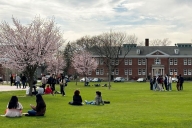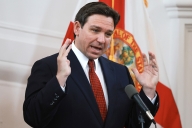You have /5 articles left.
Sign up for a free account or log in.
In June, I gave a presentation on governance and leadership at the State University of New York Executive Leadership Academy for senior administrators exploring whether they wanted to become college presidents. I began by sharing a favorite story about being asked in 1992, just days after I became president of the University of Puget Sound, to describe what college presidents do. After I gave a brief explanation, my questioner blurted out, “How did you get stuck with that job?”
Both during and after my SUNY session, several participants worried that being a college president might mean that they would be stuck with a job that was becoming untenable.
It is the case that the majority of the problems facing presidents today are consistent with those that preoccupied me more than two decades ago: how to persuade prospective students and parents that a college education is affordable and worth the cost, how to meet enrollment goals, how to improve retention and graduation rates, how best to leverage financial aid, how to position the institution strategically and then to market it, how to achieve a balanced budget year after year, how to create a vibrant campus life, how to raise lots and lots of money, how to create an effective career services operation, how to boost faculty and staff salaries, how to foster good town-gown relationships, and how to use technology to foster teaching and learning.
Although I believe that being a college president today is even more daunting than it was in 1992, I remain convinced -- as do most of the presidents whom I now advise -- that being a college president is incredibly rewarding.
A confession: during the early years of my presidency, I only thought about governance in terms of the board. For example, my board and I sought to focus the board on the strategic rather than the tactical and on policy rather than operations. We clearly defined the board’s role and responsibilities. We were intentional about attracting trustees with expertise in areas of importance.
I of course also focused on how I might most effectively work with my faculty colleagues.
But it never occurred to me to read books on leadership to learn how to do this. So it is with no small sense of irony that I confess that in the last five years I -- who was never a student of governance or leadership -- have written two books as well as lots of articles on these topics, not to speak of consulting with colleges and the universities across the country about these same matters.
My interest has been prompted by the fact that even as the problems I dealt during the initial years of my presidency still persist, it is the case that a variety of new external forces have converged to make it more challenging than ever for presidents to find the right balance in terms of governance and to be effective leaders.
Here is some of what I have learned as a consultant:
Financial Constraints Are Creating Contentiousness. The new normal for many public and private campuses of declining enrollment, increasing tuition discounts, diminished net tuition revenue and unsustainable structural deficits has led to contentiousness. Simply put, when colleges and universities are thriving or at least stable, when faculty and staff salaries are reasonable, when support for faculty by way of sabbaticals and money for faculty development are sufficient, when facilities are in good shape, and when students are able to focus on their studies rather than worrying about whether they can afford to stay in school, morale tends to be high and relationships between the faculty, the students, the administration and the board uneventful.
When resources are constrained, those relationships often become frayed or even broken. This new contentiousness has led to increasing numbers of votes of no confidence in presidents and sometimes even boards. And although such votes do not have the power they once had, they do put a tremendous strain on the faculty-president relationship.
Elected Officials Are Intervening in Campus Matters. In unprecedented ways, elected officials are making pronouncements about and sometimes taking action in relationship to matters that previously had been the province of the board and president, such as institutional mission and levels of tuition, and in some cases that had been the province of the faculty, such as curriculum and how education is “delivered.” In recent years, in advancing a notion that a college education should be utilitarian, North Carolina Governor Pat McCrory and Florida Governor Rick Scott opposed state funding for majors that they believed would not lead to jobs -- Swahili and gender studies in McCrory’s case and anthropology in Scott’s case.
Some state legislatures are advocating for more online courses, which they believe will save money. The Georgia House has approved a bill to change the name of the Technical College System of George to Georgia Career College System, a move favored by Governor Nathan Deal, despite opposition from the higher education community and the Southern Accrediting Association (SACS). Some legislatures are limiting or prohibiting tuition increases.
Governor Scott Walker of Wisconsin has even gone so far as to declare that shared governance is a problem. Specifically, when he proposed that $300 million be removed from the University of Wisconsin’s budget (the legislature has reduced the cuts to $250 million), he recommended, “In the future, by not having the limitation of things like shared governance, [the university] might be able to make savings just by asking faculty and staff to consider teaching one more class a semester.” The Legislature has joined Scott in his attack on shared governance, removing statutes that both guarantee tenure and give the faculty a critical role in determining academic matters.
In such instances, presidents often find themselves pressured both by the faculty to take a stand on their behalf and public officials to fall into line.
Who Is Responsible for the Nature and Pace of Change on College Campuses Is Increasingly Questioned. The need for more timely and even rapid decision making has raised significant questions about the nature and pace of change and also who is responsible for deciding what that change and the pace of change should be. Perhaps the best example of this tension was manifest in the 2012 decision by the University of Virginia Board of Visitors to ask for President Teresa Sullivan’s resignation because they rejected her view that change should be incremental and achieved through collaboration in favor of their belief in “disruptive innovation.” An outcry led the board to reverse that decision, but this sort of difference is now manifest on lots of campuses where faculty members are protesting administrative or board decisions about the curriculum, which was once considered the primary responsibility of the faculty, and where presidents and boards are expressing impatience at deliberative processes that take many years and often yield no conclusion.
The public and political discourse has generally become more coarse, and this coarsening has extended to colleges and universities. Protests against speakers with whose views some group or groups do not agree are now commonplace. For example, at Haverford in 2014, a letter signed by three faculty members and fewer than 50 students protesting the choice of former chancellor of the University of California, Robert Birgeneau, as an honorary degree recipient and commencement speaker led Birgeneau to decide not to speak. A year earlier, New York City Police Commissioner Ray Kelly’s speech at Brown was shut down by shouting protestors.
In these instances, presidents often find themselves caught between advocating for freedom of speech and responding to the demands of some on their campuses to take a stand for that which the protestors believe is the right thing. University of Pennsylvania President Amy Gutmann attempted to navigate these churning waters when a large group of student protestors took command of her annual Christmas party for students at the president’s house. But when a cell phone photo -- of Gutmann joining the protestors in a “die-in” to protest the death of Missouri teenager Michael Brown at the hands of a police officer -- went viral, she earned the condemnation of her own campus security force.
Social Media Flames Controversies. As the Gutmann case demonstrates, social media has made conflicts that were once confined to a campus or at least its local community the potential subject of national and international news. The current reality is that everyone with an Internet connection can be a self-styled reporter (but without a professional editor seeking to ensure the reliability of sources, the validity of the evidence presented and even the pertinence of the story). As a result, students, faculty, staff and alumni using social media have, sometimes quite successfully, organized efforts to force the resignations of any number of college presidents or to rally people around their cause.
“Truthiness” Is in Ascendance. In my judgment, Stephen Colbert’s notion of “truthiness” may be the most important notion of all in that there is now a growing disregard for fact, for substantiated evidence and for logic. This has been evident in the negative political campaigns for not merely decades but centuries. What is new is that this sort of disregard for fact or evidence is now distorting the discourse on and about college campuses, the places that once again were intended to be the bastions of informed and civil discourse. (I have decided not to offer examples of such truthiness simply because I do not want to perpetuate such misrepresentations of fact, but there are plentiful examples.)
Why Should People Want to Be "Stuck" With a College Presidency? The benefits for talented and committed people who care about higher education far outweigh the negatives. I say this because I have learned that presidents can, in a way not possible in any other role in higher education, make a difference for their students, for their faculty and staff colleagues, for the quality of the education that their institutions offers and -- dare I say it -- for the larger society. And indeed, the most effective presidents I know take great pleasure in their role. These presidents also have the ability to help their colleagues and their boards focus not only on the strategic rather than merely the tactical, on policy rather than only operations but as importantly on the significant rather than the trivial.
But what can presidents do to temper the negative challenges?
Presidents Need the Vision Thing. In my experience, the best presidents clearly articulate and persuasively advocate for the institution’s mission. And in order to provide leadership, they also need to have the “vision thing,” articulating a direction for the institution that is based on genuinely listening to their colleagues and having learned about and respecting the history, culture, values and traditions of their institution even as they may advocate significant changes that they believe are required by their institution’s opportunities and challenges.
Presidents Need to Avoid Polarization. Presidents need to make it a priority to try to avoid polarization. When, for example, presidents are contemplating launching a planning process, whether large or small, they need to be sure that all the appropriate voices are around the table. Then, once the process has been defined, presidents need -- in writing, in speeches and even in informal conversations -- to clarify the process for those affected by it. They need particularly to identify the goals of the process, the timetable, who will be consulted, who will be responsible for which decisions, the source of resources if new funding is needed and how success or its lack will be measured. Because it is human nature that if people don’t like the outcome of a process, they will criticize the process, it is important that these discussions about process happen at the outset and not the conclusion of the process.
Presidents Need to Clarify the Meaning of Shared Governance. Because shared governance is defined and practiced differently on different campuses, I think it essential that presidents clarify that the board has ultimate responsibility for what I like to think of as the health and integrity of the institution in all its aspects, even as the faculty traditionally has primary responsibility for academic matters. On those campuses that have endorsed the American Association of University Professors 1966 Statement on Government of Colleges and Universities, it is especially important that everyone understand the nuances of who is responsible for and has the authority to make which decisions.
Specifically, even as the AAUP assigns faculty “primary responsibility for such fundamental areas as curriculum, subject matter and methods of instruction, research, faculty status, and those aspects of student life which relate to the educational process,” the statement notes, “the governing board of an institution of higher education in the United States operates, with few exceptions, as the final institutional authority,” delegating operational responsibility to the president. The statement further affirms the role of the board even as it stresses the importance both of the board using that ultimate responsibility judiciously and also communicating the reasons for its decisions about matters for which the faculty traditionally has primary responsibility.
Specifically, AAUP declares, “the power of review or final decision lodged in the governing board or delegated by it to the president should be exercised adversely only in exceptional circumstances, and for reasons communicated to the faculty.” Later, AAUP specifies that board and administration should “concur with faculty judgment except in rare instances and for compelling reasons which should be stated in detail.”
Presidents Should Avoid Demonizing the Faculty to the Board and Vice Versa. Effective presidents do not demonize the faculty, and they discourage the faculty from demonizing the board. They help their trustees value the faculty’s expertise in academic matters and also help them understand academic values and culture. For example, it is important for board members to understand the value of the faculty who are independent critical thinkers and who, in the words of a former colleague of mine, Puget Sound Professor Emerita Suzanne Barnett, “think otherwise.” Good presidents also help board members understand rather than disdain the belief on the part of many faculty members that an extended and deliberate process protects integrity and preserves academic quality.
Presidents should further help their faculty colleagues understand that board members are volunteers who have accepted that they fiduciary responsibility for the institution, i.e., that they are entrusted with its well-being. It is in fact good for the campus community generally to understand that trustees are not paid for service but are expected to donate, often in significant ways, to the college or university and that many board members have their own deep ties to the institution, as alumni, parents and/or members of the local community.
Presidents Need to Inspire the Campus to Think Institutionally. At the same time, effective presidents inspire their faculty colleagues to focus on institutional health rather than faculty processes, prerogatives and interests of individuals or departments. Today, they also need to encourage the faculty to exercise its primary responsibility for academic matters in timely and collaborative ways rather than risk becoming increasingly marginalized and ignored by impatient boards. Presidents further need to require that their staff colleagues work together collaboratively, again thinking institutionally and not functionally.
Assuming the presidency doesn’t mean “going over to the dark side.” The cliché that the administration is the dark side is itself pernicious if it in fact discourages those faculty members and senior administrators with leadership abilities from seeking the presidency. To the contrary, in these challenging times, our colleges and universities, perhaps more than ever, need presidents who understand that academic values must be at the heart of all that we do.








